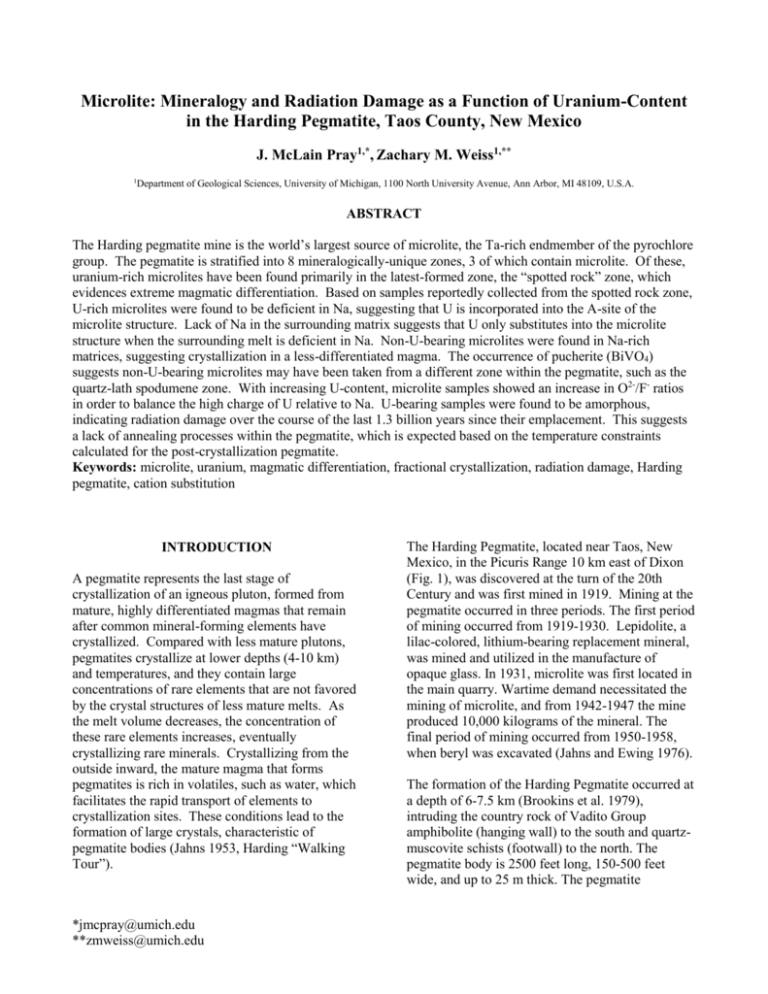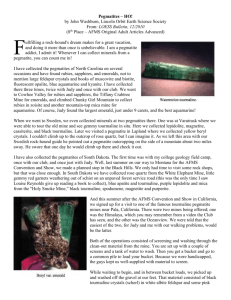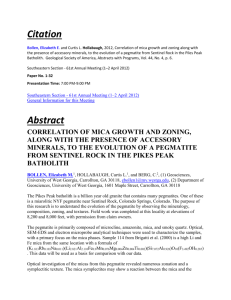Analyses of Microlite samples
advertisement

Microlite: Mineralogy and Radiation Damage as a Function of Uranium-Content in the Harding Pegmatite, Taos County, New Mexico J. McLain Pray1,*, Zachary M. Weiss1,** 1 Department of Geological Sciences, University of Michigan, 1100 North University Avenue, Ann Arbor, MI 48109, U.S.A. ABSTRACT The Harding pegmatite mine is the world’s largest source of microlite, the Ta-rich endmember of the pyrochlore group. The pegmatite is stratified into 8 mineralogically-unique zones, 3 of which contain microlite. Of these, uranium-rich microlites have been found primarily in the latest-formed zone, the “spotted rock” zone, which evidences extreme magmatic differentiation. Based on samples reportedly collected from the spotted rock zone, U-rich microlites were found to be deficient in Na, suggesting that U is incorporated into the A-site of the microlite structure. Lack of Na in the surrounding matrix suggests that U only substitutes into the microlite structure when the surrounding melt is deficient in Na. Non-U-bearing microlites were found in Na-rich matrices, suggesting crystallization in a less-differentiated magma. The occurrence of pucherite (BiVO4) suggests non-U-bearing microlites may have been taken from a different zone within the pegmatite, such as the quartz-lath spodumene zone. With increasing U-content, microlite samples showed an increase in O2-/F- ratios in order to balance the high charge of U relative to Na. U-bearing samples were found to be amorphous, indicating radiation damage over the course of the last 1.3 billion years since their emplacement. This suggests a lack of annealing processes within the pegmatite, which is expected based on the temperature constraints calculated for the post-crystallization pegmatite. Keywords: microlite, uranium, magmatic differentiation, fractional crystallization, radiation damage, Harding pegmatite, cation substitution INTRODUCTION A pegmatite represents the last stage of crystallization of an igneous pluton, formed from mature, highly differentiated magmas that remain after common mineral-forming elements have crystallized. Compared with less mature plutons, pegmatites crystallize at lower depths (4-10 km) and temperatures, and they contain large concentrations of rare elements that are not favored by the crystal structures of less mature melts. As the melt volume decreases, the concentration of these rare elements increases, eventually crystallizing rare minerals. Crystallizing from the outside inward, the mature magma that forms pegmatites is rich in volatiles, such as water, which facilitates the rapid transport of elements to crystallization sites. These conditions lead to the formation of large crystals, characteristic of pegmatite bodies (Jahns 1953, Harding “Walking Tour”). *jmcpray@umich.edu **zmweiss@umich.edu The Harding Pegmatite, located near Taos, New Mexico, in the Picuris Range 10 km east of Dixon (Fig. 1), was discovered at the turn of the 20th Century and was first mined in 1919. Mining at the pegmatite occurred in three periods. The first period of mining occurred from 1919-1930. Lepidolite, a lilac-colored, lithium-bearing replacement mineral, was mined and utilized in the manufacture of opaque glass. In 1931, microlite was first located in the main quarry. Wartime demand necessitated the mining of microlite, and from 1942-1947 the mine produced 10,000 kilograms of the mineral. The final period of mining occurred from 1950-1958, when beryl was excavated (Jahns and Ewing 1976). The formation of the Harding Pegmatite occurred at a depth of 6-7.5 km (Brookins et al. 1979), intruding the country rock of Vadito Group amphibolite (hanging wall) to the south and quartzmuscovite schists (footwall) to the north. The pegmatite body is 2500 feet long, 150-500 feet wide, and up to 25 m thick. The pegmatite crystallized into eight mineralogically-distinct subhorizontal zones, each between 5 and 20 feet thick, which date in age from 1.529 Ga to 1.121 Ga, The rose muscovite and lepidolite zones are secondary, hydrothermal replacement zones, and the perthite zone was formed post-crystallization from exsolution processes (Figs. 2-3) (Jahns and Ewing 1976, Lumpkin et al., 1986). Microlite is an isometric oxide of space group Fd3m, representing the Ta-rich end member of the pyrochlore group. Minerals of the pyrochlore group have the general formula A2-mB2X6Y1-n, where m and n range from 0 to 1. The cubic A-site typically contains Na and Ca, but may include Pb, K, Mg, Mn, Bi, Ba, Ce, Cs, Sn, Sr, Th, U6+, U4+, Th, Y, Zr, Fe2+, Sb, or REE; the octahedral B-site typically contains Ta5+ and Nb5+, but may contain Ti, Fe, W, Nb or Sn; the Y-site includes O, OH and F; and the X-site normally contains only O (Lumpkin et al. 1986, Barthelmy 2009). In order to be considered microlite, the mineral must contain more Ta than Nb, and the sum of Nb and Ta must exceed double the amount of Ti. The ideal end member formula of microlite is NaCaTa2O6F. In the molecular structure, B-site octahedra are arranged in hexagonal channels, into which the A-, X-, and Ysite ions are found (Figs. 4, 7) (Lumpkin 1989). In pegmatites, microlite is one of the last minerals to crystallize, after the melt has become differentiated and saturated in Ta. This late-stage crystallization is evident in the Harding pegmatite, where microlite is found protruding into cracks and cavities and as replacement pseudomorphs after spodumene (Brookins, Ewing et al. 1979). Primary microlite is found in two central, late-forming zones, the microcline-spodumene zone (“spotted rock”, named for purple lepidolite replacements that occur throughout the zone), and the quartz-lath spodumene zone, as well as the perthite zone (see Fig. 2). Microlite crystals mined at the pegmatite ranged in size from microscopic crystals and grains to large euhedral crystals between .2 and .8 inches wide. Rarer microlite crystals were found to be up to 3 inches long (Jahns and Ewing 1976). The late crystallization of microlite within the pegmatite led to the incorporation of many rare elements other than Ta, especially in the final stages of the cooling process. Of the three zones containing microlite, U6+-bearing samples were found primarily in the latest-forming spotted rock zone (see Fig. 3), some containing up to 5 weight% U (Brookins et al. 1979). The high concentration of U, coupled with the old age of the pegmatite, makes the spotted rock zone a likely type-locality to find metamict crystals. Accordingly, fission and -recoil paths have been discovered in many U-bearing microlites from the Harding pegmatite (Lumpkin 1989). The purpose of this paper is to present our analyses of microlite samples reportedly collected from the spotted rock zone. We examined the ionic content of the microlites and surrounding matrix as a function of U-content. Finally, we sought the presence of radiation damage in the U-bearing microlites. EXPERIMENTAL METHODS SEM: Microlite thin sections were carbon coated to allow electrical conductivity. Samples were analyzed at 20keV. Microlite’s possession of Ta gives the mineral high density (S.G. 4.2-6.4), due to the high atomic number of Ta and tight radical TaO bonds created by Ta’s high oxidation state. This high density allows microlite grains to be distinguished visually from the matrix in SEM imaging. EDS analysis determined bulk chemical composition of both microlite crystals and matrix. Optical Microscopy: Microlite samples were observed under optical microscopy utilizing PlanePolarized Light as well as Cross-Polarized Light. Microlite’s isotropic properties allowed it to be identified in XPL. Samples were analyzed for presence of iron staining, which indicates secondary precipitation in cracks and voids caused by radiation damage. Raman Spectroscopy: Raman spectra were taken of microlite samples, utilizing an Argon Beam. Raman spectra were compared to known microlite spectra to confirm the presence of microlite. Ubearing samples were examined for broadening of absorption peaks, indicative of amorphism that suggests radiation damage. Raman spectroscopy was used because the technique does not damage the samples and requires little preparation. 2 RESULTS SEM: Both U-bearing and non-U bearing microlites were found. The microlites appeared bright white, clearly delineated from the darker matrix (Figs. 5-6). EDS analysis calculated ionic ratios, which were consistent with the accepted ratios for microlite (Figs. 7-9). No radiation damage microfractures were observed in SEM analysis. However, the U-bearing microlites appeared generally less euhedral than non-Ubearing microlites, and the surrounding matrices looked more disrupted in the U-bearing samples. Matrices had distinct chemical compositions (Figs. 10-12). Non-U-bearing microlites were set in a Narich matrix (Albite), while U-bearing samples were set in a Na-depleted matrix (K-spar and quartz). In addition, the rare mineral pucherite, a Bismuth Vanadate (BiVO4), was discovered in the non-Ubearing sample. Pucherite’s high density (6.25 S.G.) distinguished it clearly in the SEM, and EDS analysis confirmed the correct ionic ratios (Figs. 1315). Optical Microscopy: Microlites were identified under XPL, where they appeared extinct. In PPL, samples appeared brown, with no pleochroism and high relief (refractive index 2-2.2). No iron staining was observed in optical analysis (Figs. 16-17). Raman Spectroscopy: The Raman spectra of microlite were consistent with known microlite spectra (Fig. 18-19), confirming the SEM identification of microlite. The U-bearing microlite spectra were flat curves with broad peaks at lower intensities, indicating metamictization. DISCUSSION Microlite Structure Analysis In microlite, research documents an inverse correlation presence of U and the major A-site cations (Na and Ca), suggesting that U occupies the A-site in the crystal structure (Lumpkin et al. 1986). However, the ionic radius of U6+ is much smaller (0.073 nm) than that of Na (0.118 nm) and Ca (0.112 nm). Using Pauling’s Coordination Principal, assuming an ionic radius of O at 0.133 nm, RU/RO is 0.549, indicating preference for an octahedral coordination. This suggests that microlite would not preferentially incorporate U into its cubic A-site, unless the melt were deficient in the regular A-site cations. In such a melt, however, U would be forced to occupy the A-site, because its radius is larger than Ta (.064 nm), the typical B-site cation. The Harding pegmatite is an example of such a case. It has been noted that the bulk chemical composition of the pegmatite is “strikingly poor in Ca” (Jahns and Ewing 1976), and that magmatic differentiation significantly depleted Na in the late-formed spotted rock zone. The inverse correlation between U-content and Asite cations was observed in our samples. However, the correlation between U-content and Na-content was much stronger than the correlation between Ucontent and Ca-content. The non-U-bearing microlite sample contained 9.52 atomic% Na and 11.05 at% Ca. The U-bearing microlite sample contained 2.59 at% Na, and 8.74 at% Ca (Figs. 8-9). Given the deficiency of Ca in the melt, however, it seems more likely that U should replace Ca and not Na. This contradiction may be explained through examination of the chemical compositions of the matrices surrounding the samples. The presence of a Na-rich matrix (Fig. 10) surrounding the non-Ubearing sample and a Na-depleted matrix (Figs. 1112) surrounding the U-bearing sample indicate that the U-bearing sample crystallized in a melt much more depleted in Na. Given the depletion of Na throughout the crystallization history of the pegmatite, U-bearing microlites appear to have crystallized later than non-U-bearing microlites. Prior research also documents an increase in O2-/Fratio with increasing U-content, in order to balance the high oxidation state of U relative to Na and Ca (Lumpkin et al. 1986). This relationship is evident in our samples. The U-bearing sample contains 60.84 wt% O and 3.97 wt% F, while the non-Ubearing sample contains 49.54 wt% O and 7.20 wt% F. Radiation Damage The near-level curve of the U-bearing microlite indicates a completely amorphous structure, signifying high levels of radiation damage. Such heavy amorphization indicates a lack of annealing 3 processes in the pegmatite. Brookins et al. found that metamict microlite begins annealing between 300-400C. However, assuming a 30C/km geothermal gradient, the pegmatite’s emplacement depth indicates an approximate post-cooling ambient temperature of 180-225C. Furthermore, lepidolite replacement in the pegmatite has been constrained to temperatures of 265 + 25C (Brookins et al. 1979). These temperature constraints further confirm that annealing processes have not likely played a large role in the postcrystallization pegmatite. Sample Locations Research documents an association of bismuth and microlite, most prominently in the quartz-lath spodumene zone (Spilde 1999). The Na-rich matrix and lack of U in the microlites of the pucheritebearing sample are characteristic of formation in an earlier stage within the pegmatite, such as the quartz-lath spodumene zone. Thus, due to the lack of knowledge regarding the exact locations of the samples within the pegmatite, these observations suggest that the pucherite-containing sample may have been taken from the quartz-lath spodumene zone. would better constrain the fractional crystallization history in the Harding pegmatite and also clarify the methods by which U is incorporated into the microlite structure. Microlite analysis using Raman spectroscopy is still in its infantile stage. Additional spectra should be created from multiple microlite samples, both crystalline and amorphous, collected from diverse locations. By heating the metamict samples and comparing the Raman spectra of the resultant recrystallized microlite, the presence of radiation damage can be further confirmed and the annealing process better understood. Acknowledgements We are indebted to Professor Rod Ewing for providing the slides and resources to complete this project. We extend our thanks to Devon Renock for his guidance in conducting our research and in analyzing our samples in the SEM, and Lindsay Shuller for conducting SEM analysis. Finally, we would like to thank Maik Lang for his help in detecting radiation damage and conducting the Raman Spectroscopy analysis of our samples. REFERENCES CONCLUSIONS The strong correlation between U/Na content and the relatively weak correlation between U/Ca content is intriguing. The ability of a deficient Ca supply to linger until the late stages of crystallization, while Na becomes thoroughly depleted, contradicts Bowen’s Reaction Series. Perhaps secondary processes rereleased Ca into the melt shortly before crystallization of the spotted rock zone began. These processes are addressed elsewhere in the literature. No matter what processes were responsible for Ca’s concentration in the spotted rock zone, the assumption that all samples came from the spotted rock zone suggests that the same magmatic differentiation processes characteristic of the bulk pegmatite were still active at the late stages of crystallization. Further studies should look for subzones within the spotted rock showing Na-rich matrix around non-U-bearing microlites and Nadepleted matrix around U-bearing microlites, which may illustrate this differentiation. Such studies Amethyst Galleries' Mineral Gallery (2009), “Microlite,” accessed 10/16/09. <http://www.galleries.com/> Baldwin, J.R., Hill, P.G., Finch, A.A., von Knorring, O. and Oliver, G.J.H. (2005) Microlitemanganotantalite exsolution lamellae; evidence from rare-metal pegmatite, Karibib, Namibia. Mineralogical Magazine, 6, 917-935 Barthelmy, D. (2009) Mineralogy Database, “Microlite” and “Pucherite,” accessed 10/16/09. <http://www.webmineral.com/> Brookins, D.G., Chakoumakos, B.C., Cook, C.W., Ewing, R.C., Landis, G.P. and Register, M.E. (1979) The Harding Pegmatite; summary of recent research; Guidebook of Santa Fe Country. Guidebook - New Mexico Geological Society, 127133 Castro, J.M. and Mercer, C. (2004) Microlite textures and volatile contents of obsidian from the 4 Inyo volcanic chain, California. Geophysical Research Letters, 18, 4 Chakoumakos, B.C. and Lumpkin, G.R. (1990) Pressure-temperature constraints on the crystallization of the Harding Pegmatite, Taos County, New Mexico. The Canadian Mineralogist, 287-298 Downs, R.T. (2006) The RRUFF Project: an integrated study of the chemistry, crystallography, Raman and infrared spectroscopy of minerals, “Microlite.” Program and Abstracts of the 19th General Meeting of the International Mineralogical Association in Kobe, Japan. O03-13.,, accessed 12/08/09. <http://rruff.info/> Ewing, R. (Jun 1994) The Metamict State - 1993 The Centennial. Nuclear Instruments & Methods in Physics Research, Section B-Beam Interactions With Materials And Atoms, 1-4, 22 Ewing, R.C., A. Meldrum, LuMin Wang, ShiXin Wang (2000) Radiation-induced amorphization. Reviews in Mineralogy and Geochemistry: Transformation Processes in Minerals, 317 Jahns, R.H. (July-Aug 1953) The Genesis of Pegmatites, I. Occurrence and Origin of Giant Crystals. American Mineralogist, Vol. 38, 7-8, 563598 Jahns, R.H. and R.C. Ewing (1976) The Harding Mine, Taos County, New Mexico. New Mexico Geological Society Guidebook, 27th Field Conference, 263 Jenson, A. and Daniel, C. (2007) Evidence of radiation damage in microlite from the Harding Pegmatite, Taos County, New Mexico; an EDS and EBSF study; Geological Society of America, Northeastern Section, 42nd annual meeting. Abstracts with Programs - Geological Society of America, 1, 87 Lumpkin, G.R. (1989) Alpha decay damage, geochemical alteration, and crystal chemistry of natural pyrochlores, Doctoral thesis/dissertation, University of New Mexico, Albuquerque, NM, United States (USA), United States (USA) Lumpkin, G.R. and Chakoumakos, B.C. (1988) Chemistry and radiation effects of thorite-group minerals from the Harding Pegmatite, Taos County, New Mexico. American Mineralogist, 11-12, 14051419 Lumpkin, G.R. and Ewing, R.C. (1992) Geochemical alteration of pyrochlore group minerals; microlite subgroup. American Mineralogist, 1-2, 179-188 Lumpkin, G.R., Chakoumakos, B.C. and Ewing, R.C. (1986) Mineralogy and radiation effects of microlite from the Harding Pegmatite, Taos County, New Mexico; R. H. Jahns memorial issue; The mineralogy, petrology, and geochemistry of granitic pegmatites and related granitic rocks. American Mineralogist, 3-4, 569-588 Lumpkin, G.R., Anderson, A.J, Simmons, W.B.,Jr., and Groat, L.A. (1998) Rare-element mineralogy and internal evolution of the Rutherford #2 Pegmatite, Amelia County, Virginia; a classic locality revisited; Granitic pegmatites; the CernyFoord volume. The Canadian Mineralogist, 339-353 Lumpkin, G.R., Anderson, A.J., Simmons, W.B.,Jr and Groat, L.A. (1998) Composition and structural state of columbite-tantalite from the Harding Pegmatite, Taos County, New Mexico; Granitic pegmatites; the Cerny-Foord volume. The Canadian Mineralogist, 585-599 Lumpkin, G.R., Whittle, K.R., Rios, S., Smith, K.L. and Zaluzec, N.J. (2004) Temperature dependence of ion irradiation damage in the pyrochlores La2Zr2O7 and La2Hf2O7. Journal of Physics, Condensed Matter, 47, 8557-8570 Spilde, M. (Feb 1999) Bismuth Minerals from the Harding Mine - More than just Yellow-Green Grunge. New Mexico Geology: New Mexico Mineral Symposium, 17 The Harding Pegmatite Mine, “Walking Tour,” Department of Geology: The University of New Mexico, accessed 12/09/2009. <http://epswww.unm.edu/harding/harding.htm> 5 Fig. 1: Location of the Harding pegmatite (Fig. from Brookins et al. 1979). Fig. 2: The main zones of the Harding pegmatite, as seen on the main quarry wall. Notice central location of U-bearing microcline spodumene zone (spotted rock) and quartz-lath spodumene zone. (Figure from Lumpkin 1998). 6 Fig. 3: Ages of Harding pegmatite zones. Notice spotted rock zone is designated “whole rock,” indicating the age of the original crystals and not the replacement minerals. The rose muscovites and lepidolites are replacement minerals, and the perthites formed post-crystallization from exsolution processes. The ages marked with asterisks were extrapolated, and are viewed as anomalous. Thus the spotted rock zone is the youngest primary crystallization zone within the pegmatite (Figure from Brookins et al. 1979). Fig. 4: Unit cell of microlite. B-site octahedra are in blue, creating hexagonal channels, into which large octhedrally coordinated A-site cations, as well as X- and Y-site anions are found. 7 Fig. 5: Microlite in non-U bearing sample. Notice euhedral nature of the grains and generally undisturbed matrix. Fig. 6a: SEM image of U-bearing microlite sample. Notice subhedral nature of the grain and fracturing in the matrix. Fig. 6b: SEM image of U-bearing microlite sample. Notice subhedral nature of the grain and fracturing in the matrix. Color contrast has been reduced in this image in order to see the surface texture. 8 Microlite Molecular Weight = 529.02 gm Sodium Calcium Tantalum Hydrogen Oxygen Fluorine 6.52 3.79 68.41 0.06 20.87 0.36 % % % % % % Na Ca Ta H O F 8.79 5.30 83.53 0.51 % % % % Na2O CaO Ta2O5 H 2O 0.36 % F Fig. 7: Accepted compositional weight percentages of microlite (Figure from Barthelmy 2009). Fig. 8: Graph shows SEM analysis of non-U-bearing microlite. Chart shows EDS calculations of ionic weight percentages of same sample. Compare with Fig. 7. 9 10 Fig. 9: Graph shows SEM analysis of U-bearing microlite. Chart shows EDS calculations of ionic weight percentages of same sample. Notice significant reduction in Na-content and increase in O2-/F- relative to Figs. 7 and 8. 11 Fig. 10: Albite matrix surrounding non-U-bearing microlite sample. Note presence of Na. 12 Fig. 11: K-spar matrix surrounding U-bearing microlite sample. Notice absence of Na. 13 Fig. 12: Quartz matrix surrounding U-bearing microlite sample. Note absence of Na. 14 Fig. 13: Pucherite (white) occurring in non-U-bearing microlite sample. Pucherite Molecular Weight = 323.92 gm Vanadium Bismuth Oxygen 15.73 64.52 19.76 ______ 100.00 % % % % V Bi O 28.07 % V2O5 71.93 % Bi2O3 ______ 100.00 % = TOTAL OXIDE Fig. 14: Accepted compositional weight percentages of microlite (Figure from Barthelmy 2009). 15 Fig. 15: SEM/EDS data for pucherite, taken from non-U-bearing sample. The sample size was smaller than the resolution of the SEM, so the data contains elements from the background matrix (Al, Fe, O) that are not included in the Pucherite. Note Bi/O/V ratios compare favorably with the accepted values in Fig. 14. High Th contents were found, but the reasons for its presence are beyond the scope of this paper. 16 Fig. 16: Photomicrograph image of Ubearing microlite from Fig. 5 (on left) in PPL. Notice brown color and high relief. Fig. 17: Photomicrograph image of Ubearing microlite from Fig. 5 (on left) in XPL. Notice extinction. 17 Fig. 18: Raman spectra of non-U-bearing crystals (blue) and U-bearing crystals (green) from the spotted rock zone. Notice the correlation between the blue curve and the known microlite Raman spectra in Fig. 19, confirming the SEM detection of microlite. Notice green curve lacks significant peaks, indicating amorphous structure due to severed chemical bonds, indicating radiation damage. Fig. 19: Known Raman spectra for microlite (from Downs 2006). Notice similarity to blue curve in Fig. 18. 18








